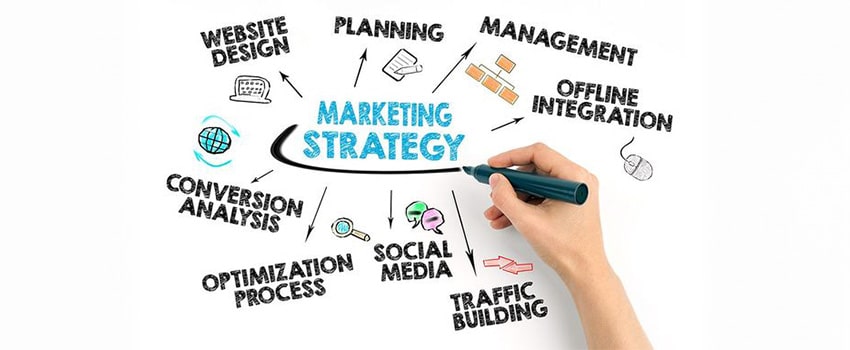
In today’s competitive business landscape, having a robust digital marketing strategy is no longer optional—it’s essential. As more companies pivot to digital platforms, the need for an effective digital marketing plan becomes increasingly critical. This article will explore the key components of an effective digital marketing strategy, offering insights into the digital marketing tactics and digital marketing mix that can drive success.

Understanding Digital Marketing Strategy
A digital marketing strategy represents the overarching scheme that outlines how businesses will make use of digital channels, including social media, search engines, email, and content marketing, in pursuit of achieving their marketing objectives. Unlike traditional marketing, which often relies on broad, untargeted messages, digital marketing allows businesses to target specific audiences with personalized content, track their performance in real-time, and adjust tactics as needed.
Importance of a Digital Marketing Strategy
A good digital marketing strategy makes certain that the direct line of all the activities of marketing is evident. It ensures that each and every action taken is in line with the overall business goals and resources are utilized effectively. Without a well-defined strategy, businesses risk wasting time and money on tactics that don’t deliver results.
- Alignment with Business Goals: The most important benefit of a digital marketing strategy is that it makes sure all the marketing activities keep aligned with the goals of your business. Whether this is increasing awareness, driving more traffic to your website, or increasing sales, a clearly defined strategy can help you reach what truly matters. This alignment allows for a unified approach where all marketing efforts—across various channels like social media, email, and search engines—work together to move your business forward. For example, if your business goal is to increase online sales by 20% in the next quarter, your digital marketing strategy might involve enhancing your website's user experience, running targeted PPC campaigns, and utilizing email marketing to nurture leads. Each of these activities is designed with the specific goal in mind, ensuring that your resources are directed toward achieving it.
- Efficient Resource Allocation: A well-defined digital marketing strategy also plays a crucial role in resource allocation. Without a strategy, businesses often fall into the trap of spreading their resources too thin, trying to be everywhere at once without a clear focus. This can lead to inefficiencies and, ultimately, wasted time and money. By contrast, a strategic approach allows you to prioritize the channels and tactics that are most likely to yield the best results for your business. For instance, if your target audience primarily uses Instagram and YouTube, your strategy might focus on creating high-quality visual content and video marketing, rather than investing heavily in channels where your audience is less active. This targeted approach not only optimizes your budget but also maximizes the impact of your efforts, leading to better ROI. It helps you make informed decisions about where to invest your time, money, and energy, ensuring that each investment contributes to the achievement of your marketing and business goals.
- Enhanced Decision-Making: Another critical aspect of a digital marketing strategy is that it provides a framework for decision-making. In the fast-paced world of digital marketing, new trends, tools, and technologies emerge regularly. While it can be tempting to jump on the latest trend, not every innovation will be suitable for your business. A well-structured strategy helps you evaluate these opportunities critically, determining which align with your goals and which do not. For example, if a new social media platform gains popularity, your strategy will help you decide whether it's worth investing time and resources into creating a presence there. You'll assess factors like where your target audience spends their time, how the platform aligns with your brand, and whether it offers a meaningful way to engage with potential customers.
- Measurement and Accountability: An effective digital marketing strategy is built on measurable objectives. By defining clear KPIs (Key Performance Indicators) and benchmarks at the outset, you create a foundation for tracking your progress and evaluating the success of your marketing efforts. This measurement capability is one of the key benefits of digital marketing, as it allows for real-time adjustments and data-driven decisions. This strategic approach makes it much easier to understand how different channels are performing, whether marketplace website traffic, social media engagement, or email open rates. You can quickly identify if one of your methods isn't working as it should and make those timely adjustments. This accountability lends itself to making sure your marketing is optimally ready for success. Moreover, the ability to measure results allows you to demonstrate the value of your marketing activities to stakeholders. Whether you're reporting to company executives, investors, or your marketing team, having data-backed insights reinforces the importance of your strategy and provides a clear understanding of its impact on the business.
- Long-Term Sustainability: Finally, a well-developed digital marketing strategy contributes to the long-term sustainability of your business. In the absence of a strategy, marketing efforts tend to be reactive and short-term, focusing on immediate wins rather than building a foundation for sustained growth. This approach can lead to inconsistent results and missed opportunities. Besides accounting for immediate goals, it needs to include a long-term outlook or vision for your brand. In other words, a digital marketing strategy will help you develop your customer base-those who are loyal and will provide you with a competitive advantage that can be sustained-by developing a consistent brand voice and presence online, and by building relationships with customers over time. For instance, content marketing strategies that focus on providing value to your audience through high-quality blogs, videos, and resources create long-term assets that continue to drive traffic and generate leads well into the future. Similarly, a strong SEO strategy ensures that your website remains visible to search engines, attracting organic traffic over the long term.
Essential Components of a Digital Marketing Plan
A successful digital marketing plan includes several key components that work together to create a cohesive strategy. These components are essential for reaching your target audience, engaging them effectively, and converting them into loyal customers.
1. Target Audience Analysis
Understanding your target audience is the cornerstone of any digital marketing strategy. This involves creating detailed buyer personas that represent your ideal customers. Consider demographics, interests, pain points, and online behaviors when developing these personas. The more you know about your audience, the better you can tailor your marketing messages to resonate with them.2. Setting Clear Objectives
Your digital marketing plan should be guided by clear, measurable objectives. These objectives could include increasing website traffic, generating leads, improving conversion rates, or enhancing brand awareness. Setting SMART (Specific, Measurable, Achievable, Relevant, Time-bound) goals will help you track progress and determine the effectiveness of your strategy.3. Competitor Analysis
Doing some competitor research of their digital marketing efforts can be a great, enriching way to develop a concept of what works and what doesn’t work within your industry. Observe their website, social media presence, content strategy, and advertising campaigns. Consider strengths and weaknesses, taking that information to further refine your strategy.4. Content Marketing Strategy
Content is the backbone of any digital marketing strategy. A well-executed content marketing strategy involves creating valuable, relevant, and consistent content that attracts and engages your target audience. This can include blog posts, articles, videos, infographics, podcasts, and more. The goal is to provide content that educates, entertains, or solves a problem for your audience, thereby establishing your brand as an authority in your industry.
5. Search Engine Optimization (SEO)
Search engine optimization is a crucial variable in the equation of your digital marketing strategy. You optimize your website and content to rank higher on various search engines’ results pages. This helps your potential customers find you when they are looking for you on the web. Some key SEO tactics include keyword research, on-page optimization, technical SEO, and building links. A proper SEO strategy will help you increase organic traffic to your website more than ever.6. Social Media Marketing
Social media platforms are powerful tools for reaching and engaging with your audience. A successful social media marketing strategy involves selecting the right platforms (e.g., Facebook, Instagram, LinkedIn, Twitter) based on where your target audience is most active. It also includes creating and sharing content that resonates with your audience, encouraging interactions, and building a community around your brand.
7. Pay-Per-Click (PPC) Advertising
Pay-Per-Click (PPC) advertising is a digital marketing tactic that allows you to place ads on search engines and other platforms, paying only when someone clicks on your ad. PPC campaigns can drive immediate traffic to your website and are particularly effective for targeting specific keywords and demographics. However, to maximize ROI, it’s crucial to carefully manage your ad spend and continuously optimize your campaigns.
8. Email Marketing
Despite the rise of social media, email marketing remains one of the most effective digital marketing tactics. It allows you to communicate directly with your audience, delivering personalized messages straight to their inbox. A successful email marketing strategy includes building a quality email list, segmenting your audience, and crafting engaging email content that drives conversions.9. Conversion Rate Optimization (CRO)
Conversion Rate Optimization (CRO) involves analyzing and improving your website and marketing efforts to increase the percentage of visitors who take a desired action, such as making a purchase or filling out a contact form. CRO tactics can include A/B testing, improving website usability, enhancing call-to-action (CTA) buttons, and simplifying the checkout process. The goal is to make it as easy as possible for visitors to convert.10. Analytics and Reporting
No digital marketing strategy is complete without a robust system for tracking and analyzing performance. Analytics and reporting tools, such as Google Analytics, provide valuable insights into how your digital marketing efforts are performing. By regularly reviewing these metrics, you can identify areas for improvement, adjust your tactics, and make data-driven decisions that enhance your overall strategy.
The core of any business today must be a well-thought-out digital marketing strategy. You’ll be able to make an impactful and unified strategy to drive results by knowing and using the key components of a digital marketing plan: target audience analysis, content marketing, SEO, social media marketing, and more. Remember to regularly monitor and optimize your efforts, and be prepared to adapt to changes in the digital landscape. With the right digital marketing mix, your business can reach new heights and achieve lasting success.
This article has provided a comprehensive overview of the key components of an effective digital marketing strategy. Whether you’re just starting out or looking to refine your existing approach, these insights will help you build a strategy that delivers measurable results and supports your business goals.




